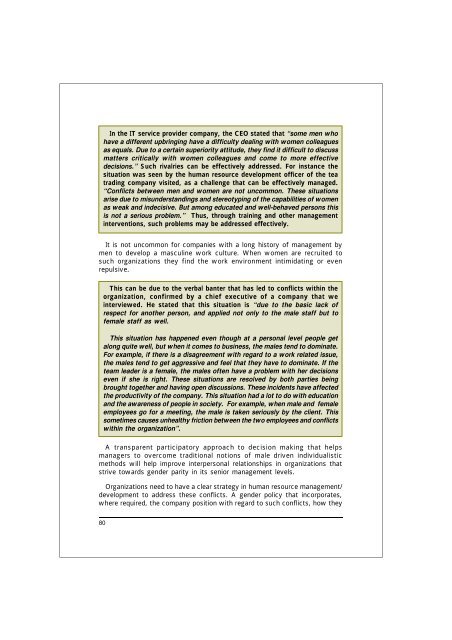Beyond Glass Ceilings and Brick Walls - International Labour ...
Beyond Glass Ceilings and Brick Walls - International Labour ...
Beyond Glass Ceilings and Brick Walls - International Labour ...
Create successful ePaper yourself
Turn your PDF publications into a flip-book with our unique Google optimized e-Paper software.
In the IT service provider company, the CEO stated that “some men who<br />
have a different upbringing have a difficulty dealing with women colleagues<br />
as equals. Due to a certain superiority attitude, they find it difficult to discuss<br />
matters critically with women colleagues <strong>and</strong> come to more effective<br />
decisions.” Such rivalries can be effectively addressed. For instance the<br />
situation was seen by the human resource development officer of the tea<br />
trading company visited, as a challenge that can be effectively managed.<br />
“Conflicts between men <strong>and</strong> women are not uncommon. These situations<br />
arise due to misunderst<strong>and</strong>ings <strong>and</strong> stereotyping of the capabilities of women<br />
as weak <strong>and</strong> indecisive. But among educated <strong>and</strong> well-behaved persons this<br />
is not a serious problem.” Thus, through training <strong>and</strong> other management<br />
interventions, such problems may be addressed effectively.<br />
It is not uncommon for companies with a long history of management by<br />
men to develop a masculine work culture. When women are recruited to<br />
such organizations they find the work environment intimidating or even<br />
repulsive.<br />
This can be due to the verbal banter that has led to conflicts within the<br />
organization, confirmed by a chief executive of a company that we<br />
interviewed. He stated that this situation is “due to the basic lack of<br />
respect for another person, <strong>and</strong> applied not only to the male staff but to<br />
female staff as well.<br />
This situation has happened even though at a personal level people get<br />
along quite well, but when it comes to business, the males tend to dominate.<br />
For example, if there is a disagreement with regard to a work related issue,<br />
the males tend to get aggressive <strong>and</strong> feel that they have to dominate. If the<br />
team leader is a female, the males often have a problem with her decisions<br />
even if she is right. These situations are resolved by both parties being<br />
brought together <strong>and</strong> having open discussions. These incidents have affected<br />
the productivity of the company. This situation had a lot to do with education<br />
<strong>and</strong> the awareness of people in society. For example, when male <strong>and</strong> female<br />
employees go for a meeting, the male is taken seriously by the client. This<br />
sometimes causes unhealthy friction between the two employees <strong>and</strong> conflicts<br />
within the organization”.<br />
A transparent participatory approach to decision making that helps<br />
managers to overcome traditional notions of male driven individualistic<br />
methods will help improve interpersonal relationships in organizations that<br />
strive towards gender parity in its senior management levels.<br />
Organizations need to have a clear strategy in human resource management/<br />
development to address these conflicts. A gender policy that incorporates,<br />
where required, the company position with regard to such conflicts, how they<br />
80
















